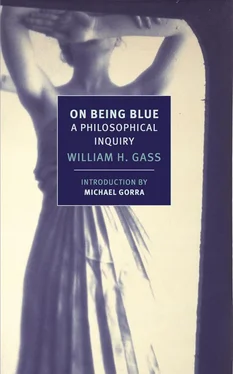Ordinary inferences are not altered by the time it takes to make them. Here, however, immediacy is essential. In short, ‘seeing’ the blue of the gentian, the storm in the clouds, or deer in their tracks, involved the same principles and was basically the same process. Genius, then, was the ability to ‘see’ a long way — swiftly. Unfortunately, the implication is that if I were stupid enough — retarded might be the right word — I would see no farther than the inside of my eye. This seems unlikely, and, although the dunce sits in the corner he’s been sent to, the corner does not close that narrowly upon him, or his conical paper crown slide that darkly to his nose.
Aristotle had no more doubt than Plato did that things were loud, sour, blue, or rough, but he had difficulty in understanding how we saw and felt and heard these qualities. Moreover, he wished to avoid Plato’s dismissal of the sensible world as a ground for knowledge. Consequently, he was driven to make a number of extraordinary suggestions. Perception, he said, is the power of receiving ‘the sensible forms of things without their matter.’ Here we tremble on the brink of something without actually toppling in, because Aristotle’s sensible forms, transmitted to us through an intervening medium called ‘the transparent,’ are tinted images, visible species, the verdigris of bronze without the bronze, the shape of the spear, first in the trembling air and then in the eye, given to us as the sharp flowing edge of a set of colors; but like a camera which peels off and spools the visible film of things, what these colors color must be supplied by the sensitive soul itself.
We reach that brink in the moment when Aristotle says:
… the sense is affected by what is coloured or flavored or sounding, but it is indifferent what in each case the substance is; what alone matters is what quality it has, i.e., in what ratio its constituents are combined….
When a colored surface sets the transparent in motion, it relays to the eye a record of the relation between light and dark which constitutes its hue, and the organ responds by establishing this relationship inside itself. Thus
… the actualities of the sensible object and of the sensitive faculty are one actuality in spite of the differences between their modes of being…
and the mind flies to another essay, this time a contemporary one by Edwin H. Land, in which the results of his experiments on color vision are summarized. It is not the eye’s response to a single wavelength, as the spectrum displays them, which causes us to perceive a color, rather
… the colors in a natural image are determined by the relative balance of long and short wavelengths over the entire scene… (‘Experiments in Color Vision’)
so that within the frequencies which make up spectral yellow, for instance, the whole range of colors can be experienced. Within spectral blue, already short or cool, the cool side will be seen as blue, the long or warm side as red. Clearly, color is the experience of a ratio.
As I should like to spell the theory now, the musician, for example, counting on the auditory laws, creates a structure he knows the mind will materialize in sounds of a certain kind. The musical score represents the music’s form in ink and paper. The disc represents it in wiggles and rounds. The performance troubles the air with the same structures. And our mind hears . But the qualities we taste in wine, touch and feel along the thigh while loving, hear as singing, sniff from the steaming pot, or observe articulate the surface of a painting, are, in fact, relations. Furthermore, the sense of passion or of power, of depth and vibrancy, feeling and vision, we take away from any work is the result of the intermingling, balance, play, and antagonism between these: it is the arrangement of blues, not any blue itself, which lets us see the mood it formulates, whether pensive melancholy or thoughtless delight, so that one to whom aesthetic experience comes easily will see, as Schopenhauer suggested, sadness in things as readily as smoky violet or moist verdigris.
Nevertheless, what we saw, Aristotle had to say, was not quite the color as it was embedded in its bronze. It was instead a color generalized, the species bluegreenbrownishness, expressed, to be sure, in an individuating medium of its own, yet like the particular twangs of native speech, easily replaced with Oxford’s universal intonations by any listener fastidious enough to care. Furthermore, these qualities, although slightly general in their character, were neither essential nor universal enough to figure importantly in knowledge. The shapes of things, wrapped like cigars in their shades, were informative sometimes, but perception mainly permitted us to establish the behavior patterns of plants, animals, and things, and having sequences, discover causes, hence general laws and universal schemes. In short: without color we could not perceive, nor, I suspect, remember, but the production of these qualities is never part of the basic activity of Being, and therefore an account of them is never a significant part of natural science.
Will the Bishop do better by blue? After all, he appeals to common sense and to the experience of ordinary men. Yet
It is an opinion strangely prevailing amongst men, that houses, mountains, rivers, and in a word all sensible objects have an existence natural or real, distinct from their being perceived by the understanding.
No one betrays perception more promptly than the empiricist. First he appeals to common sense, which he flouts; then to experience, which he misrepresents. How far must we search to find the reason for this strangely prevailing opinion? As it happens, the cover of my copy of Berkeley’s New Theory of Vision is blue, and when I shelve it so the sides slide between Bergson and Bradley, do they cease to be blue or bluish or even any color? Do I ever feel the likelihood of that, or wonder at the possibility?
No doubt Berkeley was right to remind us that all our statements about the qualities of things are reducible to the general prediction that if we carry out certain operations properly, we will have certain perceptions; but it does not follow from this that to be is to be perceived; rather we must be content to argue only that to be known to be is to be perceived, for there is no other way to ‘know’ perceptible qualities except by perceiving them.
Am I then wrong to believe that my copy of Berkeley remains blue though it rests in my briefcase throughout the night? Am I deceived if I think that the blue belongs to the book, not to me, though the book has my name on its flyleaf and lives on my shelves quite contentedly? Am I mistaken to maintain that this blue is a public property, as much as a park, for all to see, though my leather case and library are as private before the law as the penis behind my pants? Have I been fooled if! feel that this blue, though only a color, will suffer fading and staining, a circuit of changes like everything else on its way to oblivion? Suppose I shelve my book backward so that its raw ends stick out. How do I know that the binding has not fled with the blue I can’t see, like Peter Pan to the land of lost children, and the pages are held between Bradley and Bergson like a rosary between praying palms?
Don’t prate to me of divinity, dear Bishop, but of blue, the godlike hue, because it’s contrary to experience to assume that anything alters itself without cause; consequently I can feel certain that my Berkeley will remain blue so long as I can be confident that there is no plot afoot to dye, bleach, or rebind it. The Law of Inertia will serve us all more reliably than the allegedly omniscient though in truth often watery gaze of God.
Читать дальше












